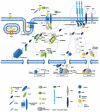Wnt/beta-catenin signaling and small molecule inhibitors
- PMID: 23016862
- PMCID: PMC3529405
- DOI: 10.2174/138161213804581837
Wnt/beta-catenin signaling and small molecule inhibitors
Abstract
Wnt/β-catenin signaling is a branch of a functional network that dates back to the first metazoans and it is involved in a broad range of biological systems including stem cells, embryonic development and adult organs. Deregulation of components involved in Wnt/β-catenin signaling has been implicated in a wide spectrum of diseases including a number of cancers and degenerative diseases. The key mediator of Wnt signaling, β-catenin, serves several cellular functions. It functions in a dynamic mode at multiple cellular locations, including the plasma membrane, where β-catenin contributes to the stabilization of intercellular adhesive complexes, the cytoplasm where β-catenin levels are regulated and the nucleus where β-catenin is involved in transcriptional regulation and chromatin interactions. Central effectors of β-catenin levels are a family of cysteine-rich secreted glycoproteins, known as Wnt morphogens. Through the LRP5/6-Frizzled receptor complex, Wnts regulate the location and activity of the destruction complex and consequently intracellular β- catenin levels. However, β-catenin levels and their effects on transcriptional programs are also influenced by multiple other factors including hypoxia, inflammation, hepatocyte growth factor-mediated signaling, and the cell adhesion molecule E-cadherin. The broad implications of Wnt/β-catenin signaling in development, in the adult body and in disease render the pathway a prime target for pharmacological research and development. The intricate regulation of β-catenin at its various locations provides alternative points for therapeutic interventions.
Figures

References
-
- Nusse R, Varmus HE. Many tumors induced by the mouse mammary tumor virus contain a provirus integrated in the same region of the host genome. Cell. 1982;31(1):99–109. - PubMed
-
- McMahon AP, Moon RT. Ectopic expression of the proto-oncogene int-1 in Xenopus embryos leads to duplication of the embryonic axis. Cell. 1989;58(6):1075–1084. - PubMed
-
- Logan CY, Nusse R. The Wnt signaling pathway in development and disease. Annu Rev Cell Dev Biol. 2004;20:781–810. - PubMed
Publication types
MeSH terms
Substances
LinkOut - more resources
Full Text Sources
Other Literature Sources

